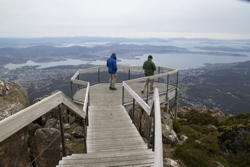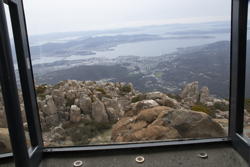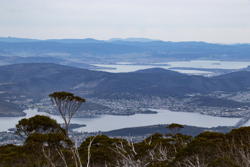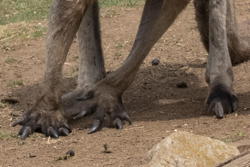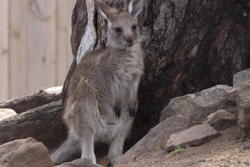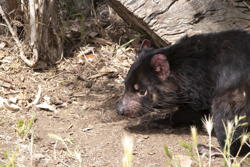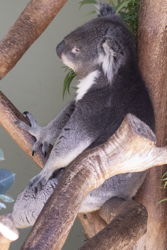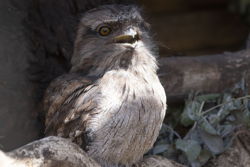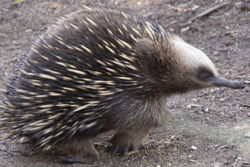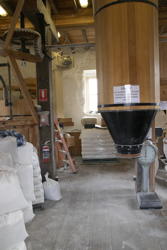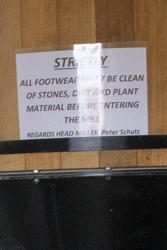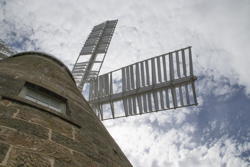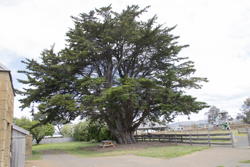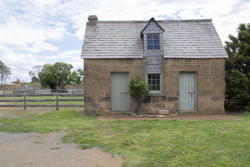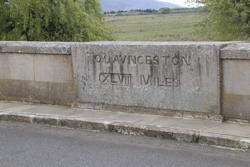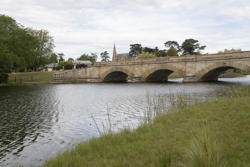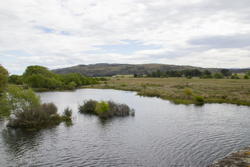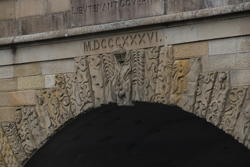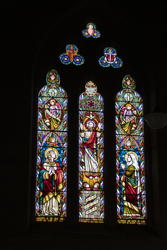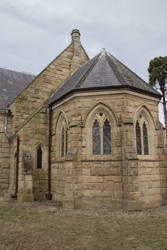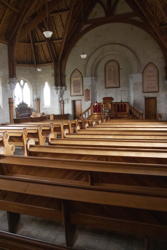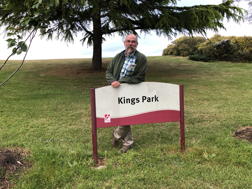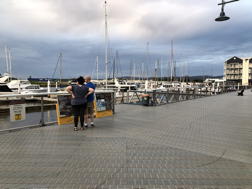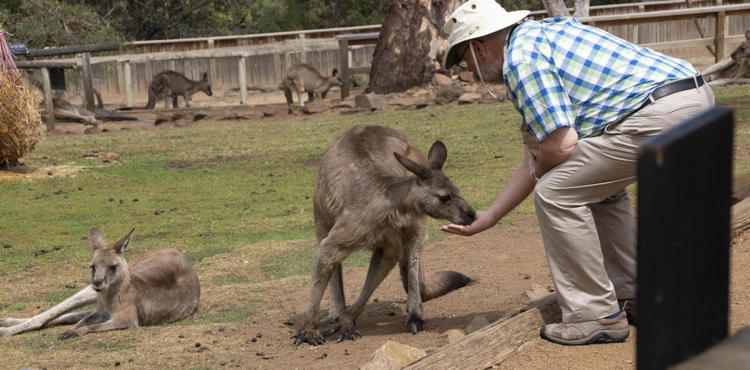
|
| Mark feeds a kangaroo at the Bonorong Wildlife Sanctuary (bigger image). |
Tuesday, 13 November:
From Hobart to Launceston,
with
sights
Somehow, today’s journal entries take up more space describing our food and drink than on what we did during the day’s drive. As a result, I’ve had to depend on Mark’s account for details.
Well before we left St. Paul, Mark had arranged for day trips by car around Tasmania for the period between Monday and the beginning of our adventure in the Tarkine, which would start on Friday. Our guide was John Lovell, of whom my journal says, «He is a bluff, chatty fellow, full of information, and good at drawing us out.» That last is a serious recommendation, since neither of us is any kind of conversationalist.
The first sights that John took us to were seen from Mount Wellington. There was an open-air observation deck, fairly windy; you see it to the right (big image, small), along with a view that includes the Tasman Bridge, which I have also cropped for the image below. Unfortunately, at this time there was enough overcast to prevent the pictures from having much snap.
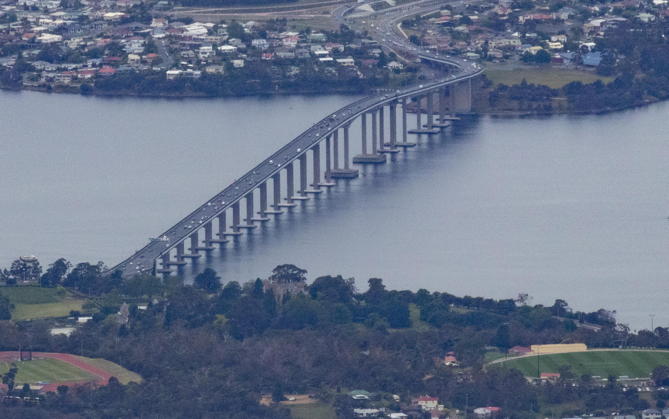
|
|
The Tasman bridge. The center was knocked out by an ill-piloted
freighter carrying zinc ore in January of 1975. A quite horrifying disaster. |
Going yet higher up, it was very windy, as you might guess from Mark’s posture in the upper left-hand picture at the right. At the top, we were glad to get out of the wind into the enclosed observation station. I fear that I didn’t take any memorable pictures once we were there, though. At the upper right, is an informative poster that you should be able to read in the large version. The lower two pictures show the estuary of the Derwent River, and the bay or estuary beyond seems to be called Pitt Water, not to be confused with Pittwater outside Sydney.
Our next stop was the Bonorong Nature Preserve, where the top picture of Mark and the kangaroo was taken. The visiting area is mostly a broad open space, but with large cages for birds and some animals like the koala. As you can see in background of the top picture, there are loads of kangaroos, most of them stretched out on the ground, to the point that Mark called it Kangaroo Lounge. Of the two pictures at the left, the left one shows a closeup from the top picture, so you can see the structure of the front paws. Notice that the rear has one big claw, and I think only one other. The picture to the right is of a joey seen from afar. Adorable!
The block at the left shows four snapshots of a sick old Tasmanian Devil that was close enough to the path for me to get a lot of nice portraits. They’re usually shown snarling, after all.
Lots of birds in cages, making photography frustrating. Mark does not have a photo of the bird to the right, but he says it’s a Sulfur-crested cockatoo.
In the block beneath the Tasmanian devils, it’s a Long-billed corella. And the parrot in the upper right there is a Yellow-tailed black cockatoo, and immediately below that is a Tawny frogmouth. These last birds are related to the familiar nightjars. (The nighjars that most of us know are the Whip-poor-will and the Nighthawk. I even heard a Chuck-will’s-widow once on Staten Island.)
At the bottom of that block are a couple of special mammals, though. The koala was sleeping, and I took several snapshots of him/her, hoping to get a different pose, but the sleep was so sound that there was no motion.
On the right is the other monotreme, beyond the Platypus, which I guess everybody knows about. It’s an Echidna, Tachyglossus aculeatus, also known as Spiny ant-eater. This guy was missing a front leg, and that’s probably the reason it was at Bonorong. (The next day, we would get closer to and more familiar with Echidnas.)
Two more pictures, before we were on our way to a lot of general sightseeing. To the left, a nice close-up of a skink, the Blotched blue-tongued lizard, whose blue tongue you can see at Mark’s page, in a video clip, toward the very end. And an Eastern rosella there on a tree rather than in a cage.
| A very short clip showing how a kangaroo goes, quadrupedally rather than by hopping. |

The famous Australian black swans, first of the interesting shots I got in Oatlands (big image, small).
We had lunch in the town of Oatlands. It’s some distance from the Hobart area, where Bonorong is located, and my pictures from there have date stamps about two hours later than those from the nature preserve. (But my journal is silent.)
We walked around a bit, and looked in the door of a really nice working windmill, used for milling grain. I confess that large or heavy-duty mechanical connections fascinate me, like the gearing that evidently takes the windmill’s power to the stones, or whatever it is that does the grinding.

|
|
And then it was time to visit Ross, which is indeed about halfway between the two biggest towns on the island, Launceston and Hobart, and considerably more interesting than Oatlands. We spent a suitably long time on the bridge, which is distinguished indeed.
From there we went to see St. John’s Church (Anglican), which I liked a lot too. Once we got in, we could admire the fine woodwork both at floor level and in the framing of the vault.
There were more than a few stained-glass windows, too. But I don’t like them, except in a place that’s designed to show them off, like the Sainte-Chapelle in Paris. I especially don’t like the nineteenth-century kind of stained glass. Anyway, I took only one picture, though you can find another on Mark’s page as well.
Within Ross, there was one other place we visited, the Tasmanian Wool Centre. It was interesting enough, but I took no pictures there to show off. Even Mark, on his page, shows only one.
John took us through all sorts of scenic sections of Tasmania on our way north to Launceston, but there was only one place we stopped for photos, and that was Campbell Town. There are several chain-saw sculptures there done by the local artist Eddie Freeman, which are surprisingly good. In our city of St. Paul, there are many sculptures done from the tree; not far from where we live, on Benhill Road, there are two; the one at the extreme right, below, of Puss in Boots, is the better, even if trashed up for the moment with a feather boa; the other, of Christopher Robin and Pooh is not so good, in my opinion (big image, small, no thumbnail).
The three at the left are Mr. Freeman’s work. They’re more carefully finished off, and I think the artistry is better than what I’ve seen here in Minnesota. Leftmost, various modes of transportation; middle, various animals both native and introduced, including a platypus; right: a soldier and a sailor, nineteenth-century style.
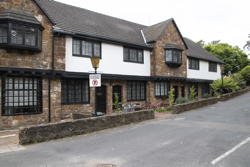
The entrance to the Leisure Inn Pennyroyal Hotel, where we stayed for three nights (big image, small).
Left off at our hotel by Mr. Lovell, we settled ourselves and walked across the lane to a pub where we enjoyed a glass of wine till the time of our reservation at the Mud Bar. We used the time for writing up our journals. Actually, I’m finding that the more walking tours we take, the less time I spend writing up the day’s adventures and discoveries. Today’s journal was almost useless: I’ve had to go to Mark’s page, and to turn aside to him when typing these pages up, to find details that I didn’t bother to record on the day of the events.
In the same way, I never take pictures of my meal (no food porn for me), but often have recorded what my meal consisted of. This day’s journal entry says, «…we walked to our restaurant, the Mud Bar, which was decorated in a contemporary fashion, and were waited on by a most attentive fellow. I started with a sashimi plate for appetizer, and it was truly excellent, even if without either soy or wasabi. Then a sesame-seared Atlantic salmon, a big hunk of fish that was perfectly cooked, although perhaps a bit bigger than I needed. No dessert, but we did have coffee.
«Mark’s bon mot for the evening: When I asked whether our waiter could possibly be gay, knowing full well that it had to be so, M said, “If he’s not, he’s wasting a hell of a lot of style.”
And that’s all for this day. Go to the next page to read what we did on Wednesday.

|
| An iPhone panorama taken at a point on our walk to the restaurant. Scroll to the right to see the rest. |
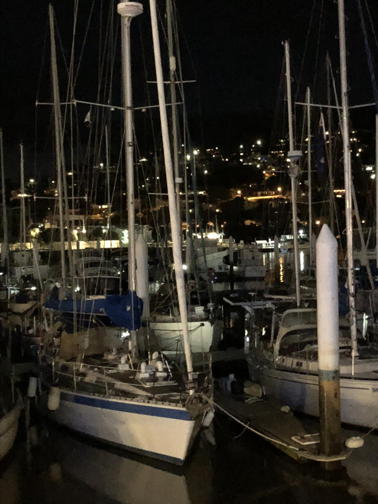

|
| Two night-time shots of the marina. |
